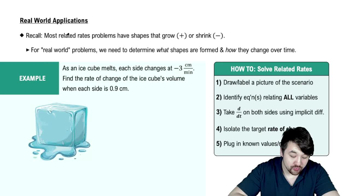Table of contents
- 0. Functions7h 52m
- Introduction to Functions16m
- Piecewise Functions10m
- Properties of Functions9m
- Common Functions1h 8m
- Transformations5m
- Combining Functions27m
- Exponent rules32m
- Exponential Functions28m
- Logarithmic Functions24m
- Properties of Logarithms34m
- Exponential & Logarithmic Equations35m
- Introduction to Trigonometric Functions38m
- Graphs of Trigonometric Functions44m
- Trigonometric Identities47m
- Inverse Trigonometric Functions48m
- 1. Limits and Continuity2h 2m
- 2. Intro to Derivatives1h 33m
- 3. Techniques of Differentiation3h 18m
- 4. Applications of Derivatives2h 38m
- 5. Graphical Applications of Derivatives6h 2m
- 6. Derivatives of Inverse, Exponential, & Logarithmic Functions2h 37m
- 7. Antiderivatives & Indefinite Integrals1h 26m
- 8. Definite Integrals4h 44m
- 9. Graphical Applications of Integrals2h 27m
- 10. Physics Applications of Integrals 2h 22m
4. Applications of Derivatives
Related Rates
Problem 95a
Textbook Question
The total surface area S of a right circular cylinder is related to the base radius r and height h by the equation S = 2πr² + 2πrh.
a. How is dS/dt related to dr/dt if h is constant?
 Verified step by step guidance
Verified step by step guidance1
Start by identifying the given equation for the total surface area of the cylinder: S = 2πr² + 2πrh.
Since h is constant, treat h as a constant value when differentiating with respect to time t.
Differentiate the surface area equation S with respect to time t using the chain rule. The derivative of S with respect to t, dS/dt, will involve the derivatives of r with respect to t, dr/dt.
Apply the chain rule: dS/dt = d/dt(2πr²) + d/dt(2πrh).
Calculate each derivative: d/dt(2πr²) = 4πr(dr/dt) and d/dt(2πrh) = 2πh(dr/dt). Combine these to express dS/dt in terms of dr/dt: dS/dt = 4πr(dr/dt) + 2πh(dr/dt).
 Verified video answer for a similar problem:
Verified video answer for a similar problem:This video solution was recommended by our tutors as helpful for the problem above
Video duration:
4mPlay a video:
Was this helpful?
Key Concepts
Here are the essential concepts you must grasp in order to answer the question correctly.
Related Rates
Related rates involve finding the rate at which one quantity changes in relation to another. In this context, we are interested in how the surface area S of a cylinder changes with respect to time as the radius r changes, while keeping the height h constant. This concept is fundamental in calculus for solving problems where multiple variables are interdependent.
Recommended video:

Intro To Related Rates
Differentiation
Differentiation is the process of finding the derivative of a function, which represents the rate of change of that function with respect to a variable. In this case, we will differentiate the surface area equation S = 2πr² + 2πrh with respect to time t to find dS/dt. Understanding how to apply differentiation to functions is crucial for analyzing dynamic systems.
Recommended video:

Finding Differentials
Chain Rule
The chain rule is a fundamental theorem in calculus used to differentiate composite functions. When applying the chain rule to the surface area equation, we will express dS/dt in terms of dr/dt, allowing us to relate the rates of change of the radius and the surface area. This concept is essential for solving related rates problems effectively.
Recommended video:

Intro to the Chain Rule
Related Videos
Related Practice





